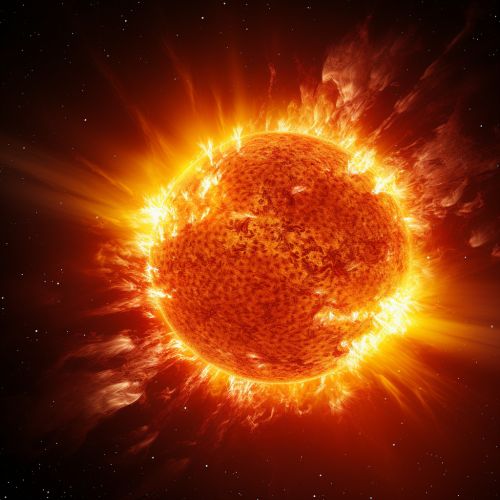Sun
Introduction
The Sun is the star at the center of the Solar System. It is a nearly perfect sphere of hot plasma, with internal convective motion that generates a magnetic field via a dynamo process. It is by far the most important source of energy for life on Earth. Its diameter is about 1.39 million kilometers, or 109 times that of Earth, and its mass is about 330,000 times that of Earth. It accounts for about 99.86% of the total mass of the Solar System. Roughly three-quarters of the Sun's mass consists of hydrogen (~73%); the rest is mostly helium (~25%), with much smaller quantities of heavier elements, including oxygen, carbon, neon, and iron.


Physical Characteristics
The Sun is a G-type main-sequence star (G2V) based on its spectral class. As such, it is informally referred to as a yellow dwarf (its light is closer to white than yellow). It formed approximately 4.6 billion years ago from the gravitational collapse of matter within a region of a large molecular cloud. Most of this matter gathered in the center, whereas the rest flattened into an orbiting disk that became the Solar System. The central mass became increasingly hot and dense, eventually initiating nuclear fusion in its core. It is thought that almost all stars form by this process.
Composition and Structure
The Sun is composed primarily of the chemical elements hydrogen and helium. At this time in the Sun's life, they account for 74.9% and 23.8% of the mass of the Sun in the photosphere, the outer atmosphere visible from Earth. All heavier elements, called metals in astronomy, account for less than 2% of the mass, with oxygen (roughly 1% of the Sun's mass), carbon (0.3%), neon (0.2%), and iron (0.2%) being the most abundant.
The Sun's structure consists of the core, the radiative zone, and the convective zone, from the innermost layer to the outermost. In the core, energy is generated by nuclear fusion, with temperatures reaching up to 15 million degrees Celsius. Energy is transferred to the radiative zone where it is then carried by radiation towards the convective zone. The convective zone forms the outer layer of the Sun, where energy is transferred by convection, with the solar material undergoing a continuous, rolling motion.
Solar Activity
The Sun's activity, known as solar activity, is driven by the solar magnetic field. The solar magnetic field changes on an approximately 11-year cycle. The cycle includes old magnetic fields being stripped off the Sun's surface and carried away by the solar wind, and new magnetic fields being created through the process of solar dynamo. This cycle is a complex and not yet fully understood process.
Solar activity includes sunspots on the surface of the Sun, solar flares, and solar prominences. These phenomena can impact Earth's natural systems. For example, solar flares can disrupt communication systems and power grids on Earth. They also produce spectacular auroras in Earth's polar regions.
Observation and Impact
The Sun has been an object of veneration in many cultures throughout human history. Humanity's most fundamental understanding of the Sun is as the luminous disk in the sky, whose presence above the horizon creates day and whose absence causes night. In many prehistoric and ancient cultures, the Sun was thought to be a solar deity or other supernatural entity. Worship of the Sun was central to civilizations such as the ancient Egyptians and the Inca.
In the modern era, the Sun has a profound influence on the Earth's climate and weather. The Sun's light, along with Earth's rotation and the tilt of Earth's axis relative to its orbit around the Sun, causes the seasonal changes on Earth. The Sun's heat drives the weather patterns on Earth through the heating of the atmosphere, oceans, and continents.
